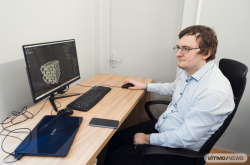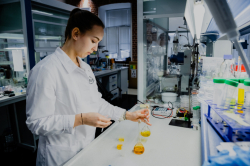You’ve been a scientist for over a decade. How did you choose this career path?
I have a funny story about that. Some time ago, my friend was defending his PhD thesis and I came to support him. At the party after the defense, an esteemed researcher, a DSc, was asking everyone the same question: “How did you get into science?” All around me were people with PhDs or significant experience and all of them had similar stories: they saw a chemical experiment as a child or found a book on chemistry in their parents’ library, or had a cool chemistry teacher at school – and that led them to think that chemistry was their dream. None of that was relevant to me: I hadn’t run experiments as a child, had never looked for topical books, and my chemistry teacher was “ordinary.” It was just a series of good and bad decisions that had landed me in that place. So I said to everyone, “Well, it seems like I am not a scientist.” It was an answer nobody had expected, so everyone just laughed.
Like many kids, I chose my career based on the examples I saw around me. My peers wanted to be firefighters or teachers, and I wanted to be a doctor. I was so driven by that goal that I even started focusing on biology and chemistry at school. But as I was nearing graduation, I realized how much responsibility for patients is involved in a doctor’s daily life – and I knew it wasn’t something I could handle. My chemistry tutor recommended I consider the Specialist’s degree program in organic chemistry at D. Mendeleev University of Chemical Technology of Russia. I followed his advice and started studying chemical technologies and learning to work with equipment. Starting from my third year of studies there, I interned at the N. D. Zelinsky Institute of Organic Chemistry of the Russian Academy of Sciences, where I learned to plan reactions, produce new compounds, and write research papers.

Alena Kulakova. Photo by Dmitry Grigoryev / ITMO.NEWS
You’ve also studied in France. Tell us a bit about that.
It so happened that the A.N. Nesmeyanov Institute of Organoelement Compounds of the Russian Academy of Sciences was “next door” to the N. D. Zelinsky Institute of Organic Chemistry, where I did my internship. So, as I was doing my PhD studies at the A.N. Nesmeyanov Institute of Organoelement Compounds of the Russian Academy of Sciences, I was offered to be part of a double degree program run by the French embassy in Russia. My studies involved a lot of traveling between the two countries and strict deadlines. With my supervisors in Moscow and in France, we planned my experiments and their schedule.
What kind of research did you do then?
I developed complexes that contain lanthanides, rare earth metal ions. They are interesting because they luminesce on their own and the intensity of their luminescence depends on various factors, such as chemical environment, molecular structure, and temperature. By manipulating their chemical composition, we aimed to create a contrast agent for MRI and tissue and cell visualization, but we ended up with a monomolecular thermometer. This is a single compact and biocompatible molecule that monitors temperature in a specific location with an accuracy of 0.1 Kelvin and responds to changes in temperature with luminescence of varying intensity. Additionally, these molecules possess not only luminescent but also magnetic properties, serving as a multifunctional contrast agent for MRI. Potentially, this thermometer may be implanted into the human body to detect localized cancer cells, as they are typically warmer than healthy ones.
In your experience, how is education in France different from the system we are used to in Russia?
My PhD studies were a time of many firsts for me: my first time on a plane, my first European country, a different language, and many differences in daily routines. In France, students were expected to be more mobile and ready to collaborate with other teams and institutions. On the one hand, this approach allows you to see what everyone else is doing and find the topic you want to study, as well as collaborators for your research. On the other hand, you can be left with a feeling that you’ve tried a little bit of everything but haven’t actually acquired any fundamental knowledge.
In Russia, value is placed on scientific schools: you start your path as a student, acquiring all the experience of your research group, and then become a visionary leading the next generation of students. The idea of spending your whole life at the same institute may sound boring, but this approach actually has merit. For instance, a recent study has examined the secret of success of Cambridge’s Laboratory of Molecular Biology, which has produced many Nobel Prize laureates. One of the reasons for it was the lab’s established scientific school and the passing of knowledge between generations. Over the years, the lab welcomed James Watson, Francis Crick, and Maurice Wilkins, who discovered the structure of DNA, Michael Levitt, who developed computer modelling of chemical processes, and Gregory Winter, who came up with a way to create new proteins and imbue them with target properties.
Two years ago, you joined the team of ITMO’s Faculty of Physics as an ITMO Fellow. Was the move from Moscow to St. Petersburg a hard decision?
I had been thinking about changing my job and thanks to a lucky coincidence I saw the postdoc vacancy at ITMO’s School of Physics and Engineering. Then, I decided to change everything – the topic of my work, my team, and even the city I live in. By the way, I am one of the very few people with a PhD in chemistry at the Faculty of Physics. You might ask: “What would a chemist do at a physics faculty?” But thanks to this combination of knowledge, we can tackle interdisciplinary studies: for instance, I can synthesize new materials and the physicists on my team can analyze their optical properties.
I love that ITMO and the School of Physics and Engineering in particular are very alive, very open-minded. It can sometimes be hard to deal with the strict hierarchy at universities: with any issue, you have to obey your seniors. At ITMO, you can easily approach anyone with any kind of discussion.

Alena Kulakova. Photo by Dmitry Grigoryev / ITMO.NEWS
What kind of research do you now do at ITMO?
Under the supervision of Valentin Milichko (a leading researcher at ITMO’s Faculty of Physics, the head of the project on 2D MOFs as an alternative silicon for microelectronics – Ed.), we design, synthesize, and study the optical properties of various new materials, including metal-organic frameworks (MOFs). These hybrid materials are easy to produce at the lab from accessible raw materials. In their structure, they are like porous sponges, capable of absorbing and transporting various substances – which makes them highly multipurpose.
For example, last year, BASF, one of the world’s biggest chemical companies, launched the production of MOFs as a solid sorbent for carbon dioxide. Additionally, such materials can be used to process excess polyester and spandex to make hydrophobic surfaces, such as new clothing.
Currently, we are focusing on two areas of application for MOFs. One of them involves lasing materials, which are capable of switching wavelengths and emitting intense light of the same frequency with a constant phase difference across a wide spectral range. Based on such materials, we can create microlasers for optical computing or for detecting target cells in the body. From these frameworks, we are producing incredibly transparent crystals that allow laser beams to pass through them without any distortion, while remaining cool and intact. These crystals will help amplify the beam across a broad spectral range in laser setups.
Our second MOF project involves flexible ligands – organic molecules that can change the spatial arrangement of atoms by rotating around their bonds. Imagine the framework as a periodic structure in the form of a crystal lattice that does not change. The ligands act as connecting organic molecules within the framework that can shrink and stretch. With their help, we can alter the distances between the nodes of the lattice and make the “inside” of the framework vibrate. This phenomenon is known as the “breathing” of the system. It can be used, for example, for gas sorption or drug delivery within the body.
AI is the talk of the town in many fields – do you use it in your work?
MOFs have been known since the 1990s and over this time, they’ve been studied through and through, making for a solid database. We know our way around it, but AI helps us select the necessary combination for synthesis or spots an interesting pattern much faster than a human would. You have to be careful, though, because if we ask AI to model the end result of a reaction, it can differ from the one we will actually acquire. However, this way we would still know at least the approximate result and will spend much less time looking for the best option.
What do you like most about being a scientist?
I like everything I get to do at ITMO, but most of all working as a part of a small team at my lab or even, sometimes, on my own. Such work has its aspects: for instance, you have to be patient and not to expect the result here and now. You often can’t get a perfect reaction on the first try and you have to constantly look for what went wrong and you can fix it. You get used to mishaps and learn to quickly analyze and make decisions – those may or may not be successful, but you keep your head high and still keep on working.

Alena Kulakova. Photo by Dmitry Grigoryev / ITMO.NEWS
And what is the hardest for you?
Presenting at conferences. Even if my paper is acknowledged and published in a highly cited journal, even if I am confident in it, I can still stumble on any question from the audience. To help with that, I signed up for a public speaking course at ITMO and now I use any public talk as practice ground.
I’d love to become a speaker who can present their work in an engaging way. My colleague from the Faculty of Physics, Sergey Rzhevskyi, is a great example for me. He helped attract the Titan group as our industrial partner. We are developing a method for producing N-methylpyrrolidone using microfluidic technologies. N-methylpyrrolidone is a versatile solvent used in many fields, from the oil industry to pharmaceuticals. Its production is kind of like cooking borscht: all the ingredients are placed into a giant vat and, roughly speaking, boiled. However, some products may stick to the walls, leading to the formation of byproducts. In microfluidic synthesis, we use a chip with numerous microchannels; the raw materials for synthesis are introduced through these microchannels. The reaction occurs in a continuous flow down the microchannels, and we can influence the outcome by changing the length of the reaction’s path.
What are your impressions of working at ITMO?
Here, everyone tries to help you, not only with material resources, but also with moral support. At the university, you can join many clubs and activities. It may sound obvious, but is actually very important. When you join a new team with over 400 people (and that’s the Faculty of Physics alone), all kinds of opportunities help you engage with people, including a faculty sports club, professional development courses, seminars, language clubs, and even movie nights. For instance, for two years, I’ve been attending English classes at ITMO; last summer we rafted down the River Ladoga; and recently I’ve been to a lecture where Vlad Simonyan, an engineer at the Faculty of Physics, talked about the decryption of glyphs from Easter Island.





